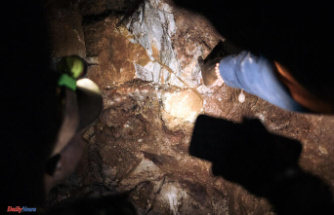Archeology in a place where people were executed - that's new in Saxony-Anhalt. For the first time there are excavations near Harzgerode and Quedlinburg. What was found?
Harzgerode/Quedlinburg (dpa/sa) - Archaeologists have discovered the first bones of hanged men on two centuries-old places of execution near Harzgerode and Quedlinburg (both in the Harz district). "These are the first excavations of this kind in Saxony-Anhalt," said archaeologist Marita Genesis of the German Press Agency. "In addition, there were several metal finds and a blue glass bead in the ground near Harzgerode."
The gallows may each consist of three oak posts wedged with stones in deep holes. Crossbeams several meters long, so-called Rähne, connected the posts. Seven to eight people could be hanged at the same time on this construction. "According to the view of the time, those sentenced to death were dishonorable and were not allowed to be buried in sacred ground in the cemetery," Genesis said.
"They hung on the gallows for a long time. The period from a few weeks to several years was set in the verdict. After that, the mortal remains were buried under the gallows." The long hanging on the gallows was part of the punishment. The convicts were thus treated as dishonorable after their death.
The archaeologists discovered the gallows near Harzgerode and Quedlinburg in a historical map. There is evidence that the gallows near Harzgerode were used between 1650 and the beginning of 1800. According to the records, there were two successive dynasties of executioner families in Harzgerode for several decades. "The Harzgerode execution site was probably already used in the Middle Ages," said Genesis.
In Quedlinburg, the gallows existed from about 1660 to 1809. "The posts in Quedlinburg were then removed and lime trees were planted in the three post holes," said the archaeologist. "The linden trees are still standing today and clearly show where the gallows stood."
During the excavation near Quedlinburg, ceramic remains, so-called Malhorn ware, were found under the former gallows. Dislocated bone fragments were also recovered. Three pits have also been uncovered. A human skeleton lay in each pit. "So these people weren't buried in a mass grave, they were laid in pits individually," Genesis said. Because of the malhorn ware, the dead are from the 17th century.
There were thousands of such places of execution throughout Germany in the Middle Ages. The death penalty was carried out publicly to deter people from committing such crimes.












